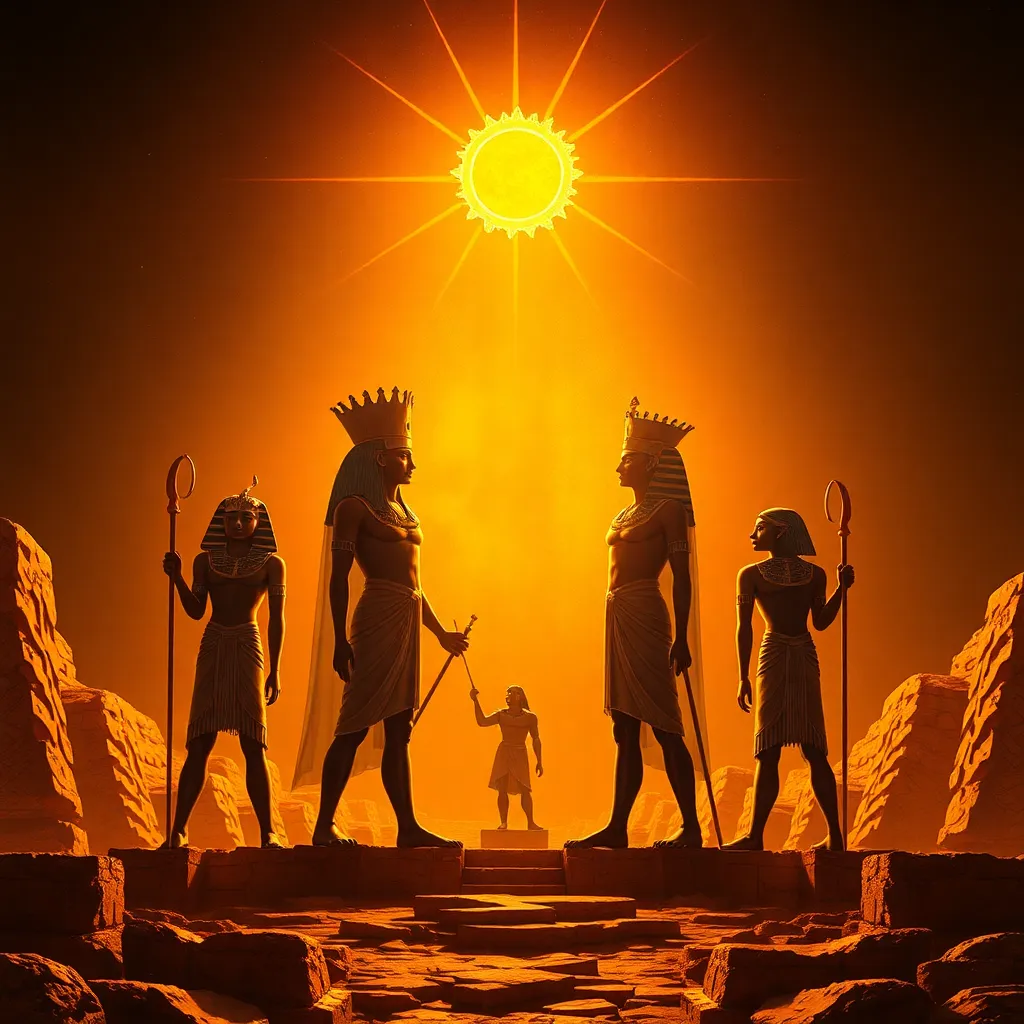The Rise of Atenism: Egypt’s Sun Worship Revolution
I. Introduction
Ancient Egyptian religious beliefs were complex and multifaceted, characterized by a rich tapestry of deities, myths, and rituals that permeated every aspect of life. The Egyptians worshipped a multitude of gods and goddesses, each representing different aspects of the natural world and human experience. Among these divine entities, the sun held a particularly esteemed place, symbolizing life, growth, and regeneration.
Atenism emerged as a significant shift in worship during the reign of Pharaoh Akhenaten, representing a revolutionary departure from traditional polytheistic practices towards a form of monotheism centered around the worship of the sun disk, Aten. This article explores the rise and fall of Atenism, highlighting its historical context, key figures, and lasting impact on Egyptian culture and religion.
II. Historical Context of Ancient Egyptian Religion
To understand Atenism, it is crucial to first grasp the broader landscape of ancient Egyptian religion:
- Polytheism and the pantheon of Egyptian gods: The Egyptians worshipped a vast array of gods, each with specific roles and attributes. Major deities included Ra, Osiris, Isis, and Horus, who were often depicted in anthropomorphic forms.
- The role of the Pharaoh in religious practices: The Pharaoh was considered the divine intermediary between the gods and the people, responsible for maintaining maat (cosmic order) through rituals and temple constructions.
- Early forms of sun worship in Egypt: Sun worship dates back to the early dynastic period, with Ra emerging as a significant solar deity. Temples dedicated to solar worship were common, and the sun’s daily cycle symbolized rebirth and renewal.
III. The Emergence of Atenism
Atenism marked a radical shift in religious thought within ancient Egypt:
- Introduction of Aten and the concept of monotheism: Aten was conceptualized as the physical sun disk, embodying a singular divine force that provided life and nourishment. This monotheistic approach was unprecedented in a society steeped in polytheism.
- Akhenaten’s role in the establishment of Atenism: Pharaoh Akhenaten, originally named Amenhotep IV, played a pivotal role in promoting Atenism. He redefined religious practices, emphasizing the worship of Aten above all other deities.
- Key texts and artifacts related to Atenism: The “Great Hymn to the Aten,” discovered in the tomb of Akhenaten, is one of the most significant texts reflecting this new religious ideology. Artifacts from the period often depict Akhenaten and his family in intimate worship of Aten.
IV. Akhenaten’s Religious Reforms
Akhenaten’s reign was marked by sweeping religious reforms:
- The transition from traditional worship to Atenism: Akhenaten dismantled the traditional priesthood and closed temples dedicated to other gods, redirecting all worship towards Aten.
- Architectural innovations: The creation of Akhetaten: The Pharaoh established a new capital, Akhetaten (modern-day Amarna), designed as a center for Aten worship, featuring open-air temples and sunlit sanctuaries.
- Changes in art and iconography reflecting Aten worship: Artistic expression shifted dramatically during this period, with a more naturalistic style emerging. Depictions of Akhenaten, his queen Nefertiti, and their children engaged in sun worship emphasized familial bonds and the divine connection to Aten.
V. Social and Political Implications of Atenism
The rise of Atenism had profound effects on Egyptian society and politics:
- Impact on the priesthood and traditional power structures: The traditional priestly class, which had enjoyed significant power through the worship of various gods, was effectively marginalized. This shift threatened the established social order.
- The role of Atenism in Akhenaten’s foreign policy: Akhenaten’s focus on Atenism influenced diplomatic relations, as he sought to promote his new religion beyond Egypt’s borders, sometimes at the expense of traditional alliances.
- Public reception and resistance to the new faith: While some embraced the new religion, many Egyptians remained loyal to the traditional pantheon, leading to tensions and resistance against Akhenaten’s reforms.
VI. The Decline of Atenism
Atenism’s prominence was short-lived:
- The death of Akhenaten and the subsequent return to polytheism: Following Akhenaten’s death, his successor, Tutankhamun, reinstated the worship of the traditional gods, abandoning the monotheistic practices of Atenism.
- Historical evidence of the backlash against Atenism: Subsequent rulers, including Ay and Horemheb, actively sought to erase the legacy of Akhenaten, dismantling monuments dedicated to Aten and restoring temples to the gods.
- The restoration of traditional gods and practices: The return to polytheism was swift, with the reinstatement of the traditional pantheon and the reinstatement of the power of the priesthood.
VII. Atenism’s Legacy
Despite its decline, Atenism left an indelible mark on Egyptian history:
- Influence on later religious movements in Egypt: Atenism’s monotheistic principles may have influenced later religious thought, including the development of Judaism and other monotheistic faiths in the region.
- Comparison with other monotheistic religions: Atenism has been compared to later monotheistic religions, particularly in its emphasis on a single deity, though it lacked the structured theology and sacred texts of these faiths.
- Modern interpretations and the significance of Atenism: Contemporary scholars and historians continue to explore Atenism’s implications for understanding the evolution of religious thought and its place in the broader context of ancient civilizations.
VIII. Conclusion
The rise and fall of Atenism is a fascinating chapter in the history of ancient Egypt, illustrating the complexities of religious evolution and societal change. Although Atenism was short-lived, its impact on Egyptian culture and religion was profound, challenging the traditional pantheon and altering the course of religious practices.
In reflecting on Atenism, we can appreciate the enduring legacy of sun worship in ancient Egypt, which continues to inspire and intrigue scholars and enthusiasts alike. The story of Atenism is not just about a radical shift in belief; it is a testament to the dynamic nature of faith and its profound connection to the human experience.




